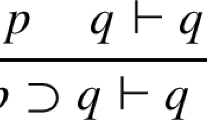Abstract
We investigate incomplete symbols, i.e. definite descriptions with scope-operators. Russell famously introduced definite descriptions by contextual definitions; in this article definite descriptions are introduced by rules in a specific calculus that is very well suited for proof-theoretic investigations. That is to say, the phrase ‘incomplete symbols’ is formally interpreted as to the existence of an elimination procedure. The last section offers semantical tools for interpreting the phrase ‘no meaning in isolation’ in a formal way.
Similar content being viewed by others
Notes
Especially On Denoting (1905), OD for short.
That so-and-so can be a complex expression seems plausible from Russells considerations in OD, p.479: “[...] ... a phrase such as any one of the following: a man, some man, any man, every man, all men, the present King of England, the present King of France, the centre of mass of the solar system at the first instance of the twentieth century, the revolution of the earth round the sun, the revolution of the sun round the earth. Thus a phrase is denoting solely in virtue of its form.
As it will be seen later ‘incomplete symbol’ will be interpreted syntactically and ‘no meaning in isolation’ semantically in our approach.
In [24] speaking of a secondary respectively primary occurrence of a definite description.
(10) and (11) are equivalent under the condition that ιxA(x) exists.
The review in question is in [26].
Definitions 3, 4, and 5 are all taken from [3], p.1ff - with minor modifications.
cf. [3], p.2f.
The proofs of both lemmata are as in Buchholz (2002/03).
More detailed proofs of the cut-lemma, and Cut-elimination are stated below.
References
Bencivenga, E., Lambert, K., van Fraassen, B. (1986). Logic, Bivalence and Denotation: Ridgeview.
Bostock, D. (1997). Intermediate Logic: Oxford University Press.
Buchholz, H. (2002/03). Beweistheorie. available online: www.mathematik.uni-muenchen.de/buchholz/articles/beweisth.ps.
Carnap, R. (1960). Meaning and Necessity: The University of Chicago Press.
Church, A. (1963). Review. The Journal of Symbolic Logic, 28(1), 105–106.
van Fraassen, B., Lambert, K., 1967. Zeitschrift für mathematische Logik und Grundlagen der Mathematik, 13, 225–246.
Gentzen, G. (1934/35). Untersuchungen über das logische Schließen. Mathematische Zeitschrift, 39, 176–210 and 405–431.
Grabmayer, C., Leo, J., van Oostrom, V., Visser, A. (2011). On the termination of Russell’s Description Elimination Algorithm. The Review of Symbolic Logic, 4(3), 367–393.
Kalish, D., Montague, R., Mar, D. (1980). Logic - Techniques of Formal Reasoning, 2nd edn: Oxford University Press.
Kaplan, D. (1972). What is Russell’s Theory of Definite Descriptions? In Pears, D.F. (Ed.), Bertrand Russell: a Collection of Critical Essays: Doubleday.
Kleene, S.C. (2000). Introduction to Metamathematics, 13th edn.: Wolters-Noordhoff Publishing.
Kripke, S. (2005). Russell’s Notion of Scope. Mind, 114, 1005–1037.
Hilbert, D., & Bernays, P. (1934). Grundlagen der Mathematik, vol. 1. Berlin: Springer.
Hilbert, D., & Bernays, P. (1939). Grundlagen der Mathematik, vol. 2. Berlin: Springer.
Lambert, K. (2003). The Hilbert-Bernays Theory of Definite Descriptions In Lambert, K. (Ed.), Free Logic: Selected Essays, (pp. 44–68): Cambridge: The University Press.
Lambert, K. (1999). Logically Proper Definite Descriptions. dialectica 53, 3(4), 271–282.
Lewis, D. (1970). The Journal of Philosophy, 67(13), 427–446.
Neale, S. (1990). Descriptions: MIT Press.
Negri, S., & von Plato, J. (2001). Structural Proof Theory: Cambridge University Press.
Negri, S., & von Plato, J. (1998). Cut Elimination in the Presence of Axioms. The Bulletin of Symbolic Logic, 4, 418–435.
Oppenheimer, P. E., & Zalta, E.N. (2011). A Computationally-Discovered Simplification of the Ontological Argument. Australasian Journal of Philosophy, 89, 333–350.
Oppenheimer, P. E., & Zalta, E.N. (1991). On the Logic of the Ontological Argument. Philosophical Perspectives, 5, 509–529.
Russell, B. (1993). Introduction to Mathematical Philosophy: Dover Publications.
Russell, B. (1905). On Denoting. Mind (New Series), 14(56), 479–493.
Scott, D. (1991). Existence and Description in Formal Logic In Lambert, K. (Ed.), Philosophical Applications of Free Logic, (pp. 28–48): Oxford University Press.
Schock, R. (1962). Some remarks on Russell’s treatment of definite description. in Logique et analyze, 5, 77–80.
Shoenfield, J. (1998). Mathematical Logic: Addison-Wesley.
Tait, W.W. (1968). Normal derivability in classical logic In Barwise, J. (Ed.), The Syntax and Semantics of Infinitary Languages, Lecture Notes in Mathematics Nr. 72. Berlin: Springer.
Troelstra, A., & Schwichtenberg, H. (2000). Basic Proof Theory, 2nd edn.: Cambridge University Press.
Whiethead, A.N., & Russell, B. (1910). Principia Mathematica, vol. I: Cambridge University Press.
Acknowledgments
The author is indebted to J. Czermak, G. Dorn, B. Fitelson, H. Leitgeb, O. Hjortland, P. Oppenheim, G. Sauermoser, and an anonymous referee.
Author information
Authors and Affiliations
Corresponding author
Rights and permissions
About this article
Cite this article
Gratzl, N. Incomplete Symbols — Definite Descriptions Revisited. J Philos Logic 44, 489–506 (2015). https://doi.org/10.1007/s10992-014-9339-1
Received:
Accepted:
Published:
Issue Date:
DOI: https://doi.org/10.1007/s10992-014-9339-1




